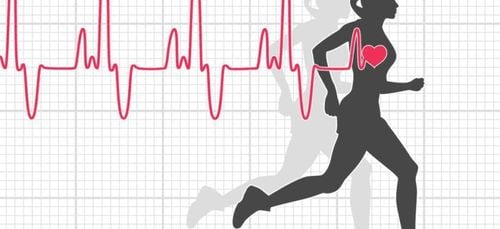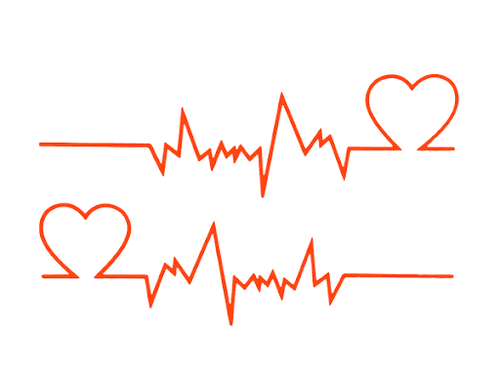This is an automatically translated article.
During exercise, your heart rate increases and increases with the pace of your activity. Blood circulates to your muscles so they can get the oxygen and nutrients they need while working. When running, you should train at 50 to 85% of your maximum heart rate. If your heart rate drops below this, you'll probably want to increase the speed to get better results from your workout. So, how high is the heart rate when running? Let's find out in the article below.
1. How to recognize a high heart rate when running
Your heart rate is measured in beats per minute. If we just rely on the fast heart rate and our body feeling extremely tired, it is not necessarily a sign of a dangerous condition when we are physically active. The key is to understand their heart rate during the run and the areas involved - the aerobic system, the lactic system, and the anaerobic system - as well as how they feel to know when they're over the threshold. term.
If heart rate monitoring is not available, scientists come up with other physical markers to estimate heart rate or how well other organs are working. In general, during running, depending on the running time, our body will be in one of three states. If we have the opportunity to use a heart rate monitor, we will easily know the heart rate zone that the body is going through. However, if it is not possible to equip a good enough heart rate monitoring system, we still have other physical markers to estimate the state in which the body and the circulatory system are in, for example like the "speaking test".
If a person can speak in full sentences, they are likely in a state of normal aerobic exercise. If a person can only say a few words at a time, they are probably in the lactic acid zone. And if a person can only utter a word or two, they may have entered anaerobic respiration. Professor Jason Lakritz, a physical therapist at Finish Line Physical Therapy in New York City, says: “If you start to feel short of breath or dizzy, your heart rate is probably getting too high and you should stop to get your breath. rest".
2. What happens when the heart rate increases during jogging?
Let's take a marathon training schedule as an example. "A marathon training plan is full of easy exercises, because the sport is mostly aerobics," says Professor Lakritz. Your body needs to become really efficient at burning fat for energy to last for a long time. Over time, your speed will likely be increased for weight loss or maintenance purposes, which means your heart rate will increase as well. However, if you consistently do easy exercises and your heart rate stops at 75% of your maximum heart rate, you won't be training this body's mechanism."
Professor Lakritz further explains: “The body is likely to be better trained through short distance running exercises because then, the body gradually gets used to and adapts to the lactic threshold, helping you to run faster. more in a shorter period of time. However, if you always run at this speed, your body will not be able to recover enough to adapt to the lactic threshold properly. Ultimately, running with a heart rate that's too high for your fitness goals will lead to time instability, burnout, or injury.”
Once the body feels tired, the heart rate will also increase even when we start to slow down. According to heart rate, the body can stay within its lactic threshold at a rate of 1.6 km every 6 minutes if you are tired from running too fast the day before. However, if you have fully recovered from the day before, you can run at a faster pace at the same heart rate range. While heart rate training is a great tool to make sure you're working out in the right areas, the numbers are the clearest proof you should be looking at.
“As you become more experienced, you should also use other cues to learn how the body is working,” says Professor Lakritz. “You can try a speech test, but this is just one way to measure how difficult your breathing is. I like to look at the data at the start of a training cycle to make sure I feel the right pace, but in a race you really want to feel like your pace is right and not be overly concerned. to those mindless numbers”.

Chạy với nhịp tim quá cao so với mục đích luyện tập của bạn có thể gây kiệt sức hoặc chấn thương.
3. What is the ideal running heart rate?
Heart rate is measured in beats per minute (bpm). During cardiovascular exercise like running, our heart rate increases. An individual's heart rate while running can be an accurate measure of how hard that person is working. As our work rate increases, so does our heart rate. Blood circulates to the muscles in the body providing the oxygen and nutrients they need so they can continue to function.
You can determine a target heart rate for running using a formula based on your own age and maximum heart rate. When running, you should train at 50 to 85% of your maximum heart rate. If your heart rate drops below this, you can increase the speed to get better results from your workout. If your heart rate is at its maximum, you may want to reduce the intensity of your workout again so you can complete your run. A heart rate monitor is a useful tool to help you monitor and control your heart rate while running.
Average heart rate while running varies from person to person. It can be affected by:
Age. Exercise level: Runners often have lower resting heart rates than non-runners. Air temperature: High temperature and high humidity can increase heart rate. Medication use: Medicines such as beta-blockers can slow the heart rate, while high doses of thyroid drugs can increase the heart rate. Stress: Emotions brought on by stress can slow or speed up your heart rate during exercise. Most runners between the ages of 20 and 45 will want to train for an average heart rate of 100 to 160 beats per minute. However, that average depends on a number of factors, including their maximum heart rate and current fitness level.
4. How to determine your ideal running heart rate
To determine your ideal running heart rate, you first need to calculate your maximum heart rate. To calculate your maximum heart rate, subtract your age from 220. Example: If you were 30 years old, your maximum heart rate would be 190. Keep in mind, this is an estimate only. A person's maximum heart rate can vary from 15 to 20 beats per minute in either fast or slow directions.
The American Heart Association recommends exercising with a target heart rate of 50 to 75% of your maximum heart rate for beginners and moderate exercisers. We can also reach 70 to 85% of our maximum heart rate during vigorous activity.
Elevating your heart rate above maximum heart rate for a long time can be dangerous to your health. That's especially true for those new to exercise. A study conducted on hockey players found that those who repeatedly exceeded their target and maximum heart rate during play had poorer recovery rates after training. They also increase the risk of cardiovascular events such as:
Arrhythmias . Chest pain. Uncomfortable. The scientists also advise runners to slow down if they consistently achieve maximum heart rate while running. In addition, they also recommend stopping exercise if you feel lightheaded, dizzy or sick.

Liên tục vượt quá mục tiêu và nhịp tim tối đa có thể gia tăng các nguy cơ biến cố tim mạch.
5. What is heart rate training?
Heart rate training based on beats per minute as a guideline for how fast a person should achieve. Heart rate training uses intervals based on each person's maximum heart rate. Here are five different ranges based on your maximum heart rate:
First range: 50 to 60% of your maximum heart rate. Second interval: 60 to 70% of maximum heart rate. 3rd interval: 70 to 80% of max heart rate. 4th interval: 80 to 90% of max heart rate. 5th interval: 90 to 100% max heart rate. Depending on your goals, you can focus on different heart rate intervals for the best results.
A good example is the form of Marathon running, which focuses on keeping a steady pace for many kilometers of running. However, marathon runners may want to spend half of this time on intervals 1 and 2. In addition, they can do some speed or interval training in zones 3 and 4. . If you are training for about 5, you may want to spend more time training between 3 and 4.
Athletes or specifically elite sprinters have You can focus more on training at intervals 4 and 5. Use a heart rate monitor to track your workouts. If you find your heart rate consistently stays in the 4 or higher range, you should slow down. You can work with a professional trainer or running coach to help you determine a workout schedule based on your goals.
Heart rate training can be an effective way to measure your body's activity level while running. Remember, don't push yourself to the point of complete exhaustion when you exercise. You should try to keep your heart rate at a comfortable level. It can be a difficult task, but it is necessary and beneficial for your health. Talk to a running coach or fitness professional to design exercises at the right level for your fitness level.
Please follow the website: Vinmec.com regularly to update many other useful information.
Please dial HOTLINE for more information or register for an appointment HERE. Download MyVinmec app to make appointments faster and to manage your bookings easily.
Reference articles: healthline.com, polar.com













